Horror in Film
Welcome to this exploration of horror in film! Today, we will learn how filmmakers use different techniques to create suspense and atmosphere in horror films. By studying elements like lighting, sound, camera angles, and colour, we can understand how filmmakers shape the audiences emotions and build tension.
This unit aligns with the NSW Stage 5 English syllabus, focusing on:
EN5-2A: Understanding and analysing how meaning is shaped in a variety of texts.
EN5-7D: Evaluating how different forms of texts influence audience interpretation and response.
Understanding Horror in Film
Horror films are designed to create fear, suspense, and tension in the audience. There are many different subgenres of horror, including:
Psychological Horror – Focuses on the mental and emotional state of characters.
Supernatural Horror – Involves ghosts, monsters, or paranormal events.
Gothic Horror – Features dark, eerie settings, often involving haunted houses.
Animated Horror – Films like Coraline and Monster House use animation to create an unsettling atmosphere while remaining suitable for younger audiences.
Horror does not always rely on blood and gore. Many films, including Coraline and Monster House, use suspenseful storytelling techniques instead of graphic content. They rely on eerie soundscapes, unsettling colour schemes, and unique camera angles to create tension (Board of Studies NSW, 2003).
What is Horror?
Cinematic Techniques in Horror
How Filmmakers Create Suspense
Lighting plays an important role in setting the mood and building tension.
Low-Key Lighting: Creates deep shadows, making scenes feel mysterious or eerie.
Uplighting: Casts shadows upward, distorting features and creating a sinister, unnatural appearance.
Backlighting: Silhouettes characters, making them appear more ominous.
Contrast Between Light and Dark: Films like Coraline use bright colours in the Other World to create an illusion of safety, which contrasts sharply with eerie darkness when danger arises.
Bordwell and Thompson (2017) state that lighting in horror films is used to heighten suspense by limiting visibility and making characters appear more vulnerable.
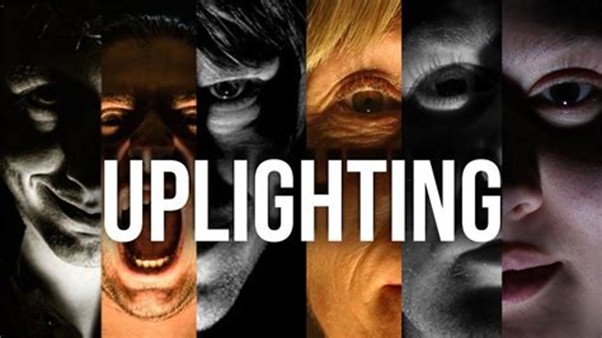

Lighting
Sound is one of the most effective tools in horror filmmaking.
Eerie Music: Slow, dissonant melodies heighten tension.
Silence: The absence of sound can make a scene more unnerving.
Jump Scare Sound Cues: Sudden loud noises used to shock the audience.
Chion (1994) suggests that sound in horror films creates psychological anticipation, making audiences anxious even before the scare occurs.
Sound Design
Different camera angles can make a scene feel claustrophobic, intense, or suspenseful.
Close-Ups: Show detailed facial expressions of fear or suspicion.
Dutch Angles: Tilted camera shots create a sense of unease.
Tracking Shots: Following a character through a dimly lit hallway builds anticipation.
Camera Angles
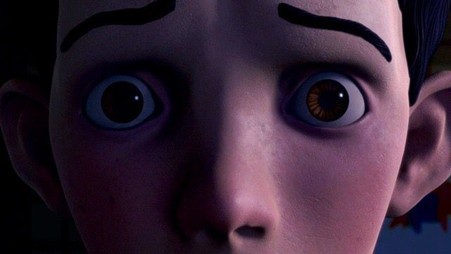

Colour palettes can enhance a film’s atmosphere.
Blue and Grey Tones: Often used to create a cold, eerie environment.
Saturated Colours: In Coraline, the Other World appears vibrant at first, making it seem welcoming before its true nature is revealed.
Bellantoni (2005) explains that colour psychology plays a key role in emotional storytelling, with horror films using dark and desaturated tones to provoke unease.
Colour and Layout
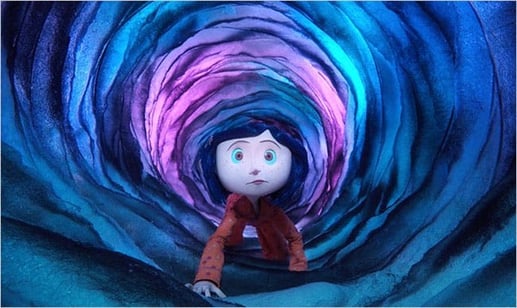

Film Case Studies
Case Study 1: Coraline (2009) – The Horror of Illusion and Control
Lighting & Colour Design
• The real world is dull and muted, making the Other World’s bright colours feel inviting.
• As the Other Mother’s deception unravels, colours shift to sickly greens and deep purples, enhancing unease.
• Shadows grow sharper, emphasising danger and entrapment.
Effect: *False security lures Coraline (and the audience) in before revealing the horror beneath.
Sound Design
• Eerie whispers from ghost children heighten supernatural tension.
• Sudden silence before scares intensifies anticipation.
• The Other Mother’s clicking fingers mimic insect movements, subtly unnerving viewers.
Effect: *Manipulates emotions, making even quiet moments feel ominous.
Mise-en-Scène (Visual Composition)
• The Other Mother’s transformation into a skeletal spider highlights her monstrous nature.
• The web-like lair reinforces themes of control and predation.
Effect: *Uncanny imagery unsettles the audience, making Coraline’s escape feel urgent.
Henry Selick’s Coraline creates horror through contrast and deception, using film techniques to shift the Other World from welcoming to terrifying.
Camera Techniques
• Close-ups capture Coraline’s growing fear and isolation.
• Dutch angles (tilted shots) make scenes feel off-balance as reality distorts.
• Tracking shots build tension as Coraline moves through shifting environments.
Effect: *Creates a sense of disorientation and claustrophobia as control slips away.
What technique is this image?
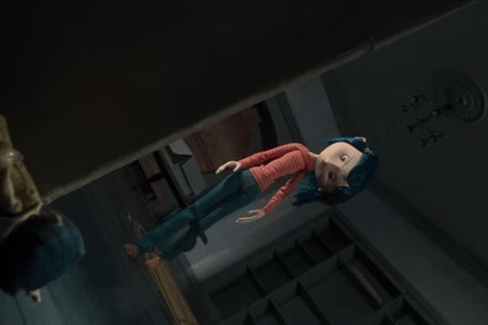


Case Study 2: Monster House (2006) – The House as a Living Creature
Lighting & Shadows
• The house is the darkest structure, making it an obvious source of fear.
• Glowing red windows resemble eyes, watching its victims.
• Shadows stretch and move unnaturally, suggesting the house has a will of its own.
Effect: *Turns an ordinary house into an ominous, lurking presence.
Sound Design
• The house groans and growls like a living creature.
• Its wood creaks and shifts before attacking, mimicking breathing.
• Abrupt silence before a scare keeps the audience on edge.
Effect: *Blurs the line between inanimate structure and living monster.
Mise-en-Scène (Visual Composition)
• The windows resemble eyes, the door a gaping mouth, making the house a literal creature.
• As the house becomes angrier, it deteriorates, reflecting its rage.
Effect: *Creates an unnatural, uncanny feeling that makes the house feel truly alive.
In Monster House, a suburban home transforms into a literal monster, using horror techniques to make a familiar setting terrifying.
Camera Techniques
• Low-angle shots make the house feel towering and menacing.
• Fast tracking shots follow characters frantically escaping, increasing tension.
• Extreme close-ups highlight fear in characters' expressions.
Effect: *Heightens suspense and emphasizes the house’s monstrous nature.

First Minute

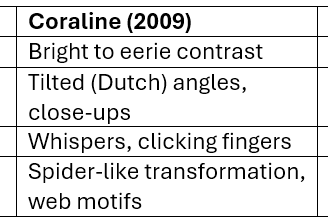
Key Takeaway
Both films build horror through suspense, not gore, using lighting, sound, and camera movement to manipulate the audience’s emotions and create horror with psychological depth.
KAHOOT
Bellantoni, P. (2005). If It's Purple, Someone's Gonna Die: The Power of Color in Visual Storytelling. Elsevier.
Bordwell, D., & Thompson, K. (2017). Film Art: An Introduction. McGraw-Hill Education.
Board of Studies NSW. (2003). Fiction, Film, and Other Texts: A Support Document for Teachers. NSW Board of Studies. Retrieved from https://www.boardofstudies.nsw.edu.au/syllabus_sc/pdf_doc/fiction_film_text_support.pdf
Carroll, N. (1990). The Philosophy of Horror: Or, Paradoxes of the Heart. Routledge.
Chion, M. (1994). Audio-Vision: Sound on Screen. Columbia University Press.
Five Senses Education. (2007). Exploring Genre: Horror. Five Senses Education. Retrieved from https://www.fivesenseseducation.com.au/exploring-genre-horror-9781921085420
Harvard T.H. Chan School of Public Health. (2023). Animated films aim to help children overcome exploitation trauma. Retrieved from https://hsph.harvard.edu/news/animated-films-aim-to-help-children-overcome-exploitation-trauma/
Harvard Gazette. (2013). Oh, the Horror! Retrieved from https://news.harvard.edu/gazette/story/2013/11/oh-the-horror/
Harvard Office for the Arts. (n.d.). Murder Most Filmable. Retrieved from https://ofa.fas.harvard.edu/blog/murder-most-filmable
Lester, C. (2021). Horror Films for Children: Fear and Pleasure in American Cinema. Bloomsbury Academic.
Simonetti, N. (2015). How Mise-en-Scene Contributes to Films and its Story – Coraline. Retrieved from https://nataliesimonetti22.wordpress.com/2015/06/02/how-mise-en-scene-contributes-to-films-and-its-story-coraline/
Medium. (2023). Unveiling Dark Secrets: A Film Analysis of Coraline. Retrieved from https://medium.com/film-cut/unveiling-dark-secrets-a-film-analysis-of-coraline-9c5e615186fe